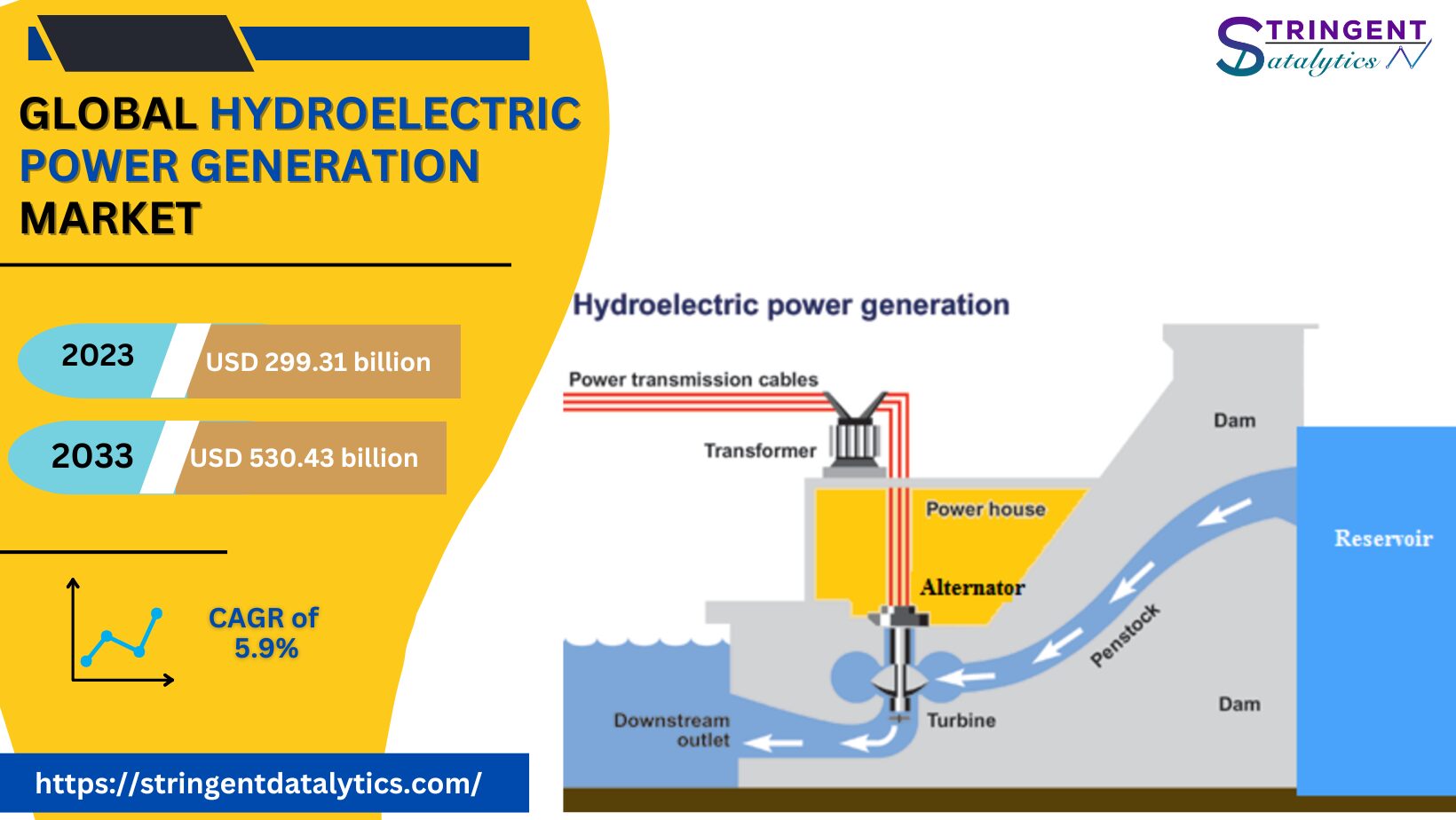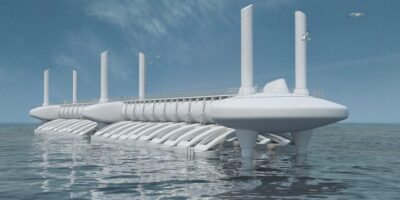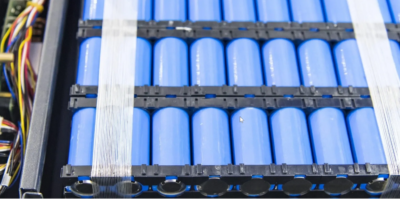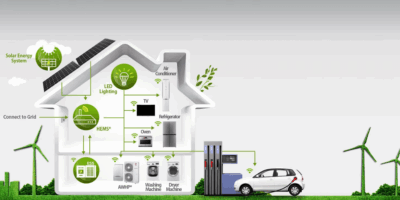The hydroelectric power generation market size has grown from USD 299.31 billion in 2023 to USD 530.43 billion in 2033 at a CAGR 5.9% during 2024-2033
Introduction
The hydroelectric power generation market has long been a cornerstone of global energy production. As one of the oldest and most established methods of generating electricity, hydroelectric power utilizes the energy of flowing or falling water to produce electrical power. This renewable energy source is critical to the transition towards more sustainable and eco-friendly power systems. This comprehensive overview examines the current state of the hydroelectric power generation market, including its historical development, technological advancements, market dynamics, key players, regional analysis, challenges, and future trends.
Historical Development
Hydroelectric power has a rich history dating back to ancient civilizations, where water wheels were used for mechanical tasks. The first hydroelectric power plant, however, was established in 1882 on the Fox River in Wisconsin, USA. Since then, hydroelectric technology has evolved significantly, becoming a dominant source of renewable energy worldwide. Throughout the 20th century, the construction of large-scale dams, such as the Hoover Dam and the Three Gorges Dam, exemplified the potential of hydroelectric power to supply massive amounts of electricity and support economic growth.
Technological Advancements
Turbine Technology
The core component of hydroelectric power generation is the turbine. Over the years, advancements in turbine design have significantly improved efficiency and capacity. Modern turbines, such as Kaplan, Francis, and Pelton types, are engineered to maximize energy conversion from water flow, catering to various site conditions and flow rates.
Pumped Storage
Pumped storage hydroelectricity represents a significant technological advancement, providing a method for energy storage and grid stability. During periods of low electricity demand, excess energy is used to pump water to an elevated reservoir. When demand is high, water is released back to generate electricity. This technology effectively balances supply and demand, contributing to grid reliability and integration of intermittent renewable sources like solar and wind.
Small-Scale Hydropower
Innovations in small-scale or micro-hydropower systems have made it feasible to harness energy from smaller streams and rivers. These systems are less invasive than large dams and can be implemented in remote or rural areas, providing a sustainable and localized power source.
Market Dynamics
Drivers
Renewable Energy Demand
The global push towards reducing greenhouse gas emissions and combating climate change has spurred significant investment in renewable energy sources, including hydroelectric power. Hydropower’s ability to provide consistent and reliable electricity makes it an attractive option for many countries aiming to diversify their energy mix and enhance energy security.
Technological Improvements
Continued advancements in turbine efficiency, materials, and construction techniques have lowered the costs associated with hydroelectric power generation. These technological improvements also enhance the viability of projects in diverse geographic locations, from large rivers to small streams.
Government Policies and Incentives
Many governments worldwide have implemented policies and incentives to promote renewable energy, including tax credits, subsidies, and feed-in tariffs for hydroelectric projects. These initiatives help offset the initial capital costs and make hydroelectric investments more attractive to private developers.
Restraints
Environmental and Social Concerns
Despite its renewable status, hydroelectric power generation can have significant environmental and social impacts. Large dams can disrupt local ecosystems, displace communities, and alter water quality and flow patterns. These concerns often lead to stringent regulatory requirements and opposition from environmental groups, which can delay or halt project development.
High Initial Costs
The construction of hydroelectric facilities requires substantial upfront investment. While operational and maintenance costs are relatively low, the initial capital expenditure for building dams, reservoirs, and related infrastructure can be a significant barrier, particularly for developing countries.
Site Dependency
Hydroelectric power generation is highly dependent on suitable geographic locations with sufficient water flow. This site-specific nature limits the potential for widespread deployment compared to other renewable sources like solar or wind, which have more flexible siting options.
Receive the FREE Sample Report of Hydroelectric Power Generation Market Research Insights @ https://stringentdatalytics.com/sample-request/hydroelectric-power-generation-market/15038/
Market Segmentations:
Global Hydroelectric Power Generation Market: By Company
Voith
andRITZ HYDRO
General Electric
China Three Gorges Corporation
Alfa Laval
Metso
China Yangtze Power
Hydro-Québec
RusHydro
Agder Energi
Duke Energy
Georgia Power
Ontario Power Generation
StatKraft
ABB
Engie
Tata Power
Global Hydroelectric Power Generation Market: By Type
Dike Type
Diversion Hydropower Station
Mixed Type
Tide
Pumped Storage
Global Hydroelectric Power Generation Market: By Application
Residential
Industrial
Commercial
Military
Defence
Transportation
Others
Regional Analysis
North America
North America has a well-established hydroelectric power infrastructure, particularly in the United States and Canada. The region benefits from abundant water resources and supportive regulatory frameworks. Recent trends indicate a focus on modernizing existing facilities to enhance efficiency and environmental performance.
Europe
Europe is a mature market for hydroelectric power, with significant installations in countries like Norway, Sweden, and Switzerland. The European Union’s commitment to renewable energy targets and carbon neutrality by 2050 continues to drive investments in hydropower. Small-scale and pumped storage projects are particularly prominent in this region.
Asia-Pacific
The Asia-Pacific region is the largest and fastest-growing market for hydroelectric power. China, India, and Southeast Asian countries are investing heavily in new hydroelectric projects to meet their rising energy demands and reduce reliance on fossil fuels. The region’s diverse geography offers significant potential for both large-scale and small-scale hydroelectric development.
Latin America
Latin America has substantial hydroelectric potential, with countries like Brazil and Colombia leading the way. Hydroelectric power is a major component of the energy mix in many Latin American countries, driven by abundant water resources and increasing energy needs.
Middle East and Africa
The hydroelectric power market in the Middle East and Africa is less developed but growing steadily. Countries like Ethiopia and Egypt are investing in large-scale projects to harness the potential of major rivers. However, the arid climate and water scarcity in many parts of the region pose challenges to widespread adoption.
Click to Purchase Hydroelectric Power Generation Market Research Report @ https://stringentdatalytics.com/purchase/hydroelectric-power-generation-market/15038/?license=single
Challenges
Environmental Impact
Hydroelectric power projects can have significant environmental impacts, including habitat disruption, fish population declines, and changes in water quality and flow. Mitigating these impacts through environmental assessments and sustainable project design is crucial but can add complexity and cost.
Climate Change
Climate change poses a dual threat to hydroelectric power generation. On one hand, increased variability in precipitation patterns can affect water availability and project reliability. On the other hand, the need to reduce greenhouse gas emissions underscores the importance of expanding renewable energy sources, including hydropower.
Regulatory Hurdles
Navigating the regulatory landscape for hydroelectric projects can be challenging. Developers must secure numerous permits and comply with environmental, social, and safety regulations. This process can be time-consuming and costly, potentially delaying project timelines.
Future Trends
Digitalization and Smart Grids
The integration of digital technologies and smart grid solutions is transforming the hydroelectric power market. Advanced sensors, automation, and data analytics enable real-time monitoring and optimization of plant operations. This enhances efficiency, reduces downtime, and supports better integration with other renewable energy sources.
Hybrid Systems
Hybrid energy systems that combine hydroelectric power with other renewable sources, such as solar or wind, are gaining traction. These systems offer complementary benefits, with hydropower providing baseload and storage capabilities, while solar and wind address peak demand and variability.
Floating Hydropower
Floating hydropower plants, which are deployed on bodies of water rather than land, represent an emerging trend. These systems can be installed in reservoirs or coastal areas, offering a solution for regions with limited land availability and reducing the environmental impact associated with traditional dam construction.
Community-Based Projects
Community-based hydroelectric projects are becoming more popular, particularly in developing countries. These small-scale projects empower local communities by providing reliable and sustainable electricity, fostering economic development, and promoting environmental stewardship.
Green Financing
The growing emphasis on sustainable finance is driving investment in hydroelectric power projects. Green bonds, climate funds, and other financial instruments are increasingly available to support the development and modernization of hydroelectric facilities. These funding sources help mitigate financial risks and attract private investment.
About Stringent Datalytics
Stringent Datalytics offers both custom and syndicated market research reports. Custom market research reports are tailored to a specific client’s needs and requirements. These reports provide unique insights into a particular industry or market segment and can help businesses make informed decisions about their strategies and operations.
Syndicated market research reports, on the other hand, are pre-existing reports that are available for purchase by multiple clients. These reports are often produced on a regular basis, such as annually or quarterly, and cover a broad range of industries and market segments. Syndicated reports provide clients with insights into industry trends, market sizes, and competitive landscapes. By offering both custom and syndicated reports, Stringent Datalytics can provide clients with a range of market research solutions that can be customized to their specific needs.
Reach US
Stringent Datalytics
+1 346 666 6655
Social Channels:




Leave a Reply